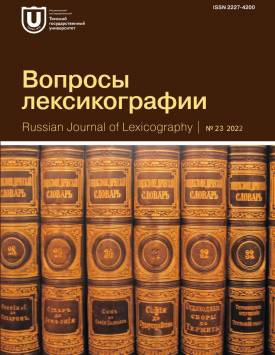Methodology for compiling a digital dictionary of homographic proper names and common nouns (based on LPD, EPD, OED)
The article describes the main approaches in compiling a projective electronic dictionary of proper names homographic with common nouns. The authors have found that the existing dictionaries of English proper names often give a general idea of onyms, their semantic, grammatical and etymological characteristics rather than a detailed description of the features of their pronunciation. In addition, homonymic groups of words that include a proper name are not mentioned in such dictionaries at all. Currently, there is no single onomasticon with representation of the entire range of phonetic variation and variability of lexical units. Thus, a dictionary of homographic proper names and common nouns, which is currently being compiled, will fill in some gaps in the system of lexicographic works. The research object is proper names that make up graphic homogroups with appellatives (about 200 groups) with a focus on their pronunciation determined by their semantics and grammatical features, as well as all possible phonetic variants of homographic proper names and appellatives registered in modern English pronouncing dictionaries - English Pronouncing Dictionary by D. Jones (EPD, 1-18 editions, 1917-2011) and Longman Pronunciation Dictionary by J. Wells (LPD, 1-3 editions, 19902008). The main aim is to develop the principles of compiling a digital dictionary of homographic proper names and common nouns. Using the resources of Oxford English Dictionary (OED), it is possible to create a more complete (combined) dictionary with indication of semantics and registration of all existing pronunciation variants of the entries. The article describes the initial stage of dictionary compilation and discusses the microstructure of lemmata for the letter “A” (9 graphic homogroups). The comparative lexicographic analysis carried out by the method of continuous sampling in EPD and LPD revealed inconsistency and insufficiency in the registration of both proper names and their meanings, as well as their British, American and some social pronunciation variants. The authors compiled a list of differences, regarding pronunciation, phonetic variants order, and semantics indication; checked the obtained information, using the OED online dictionary; then summarized and complemented the data from all three dictionaries and presented them in the entries (lemmata). The conducted linguistic research and the dictionary project are relevant for studying the problem of the English language variability. In the theoretical aspect it provides new data on the dynamics of the English language development, clarifies the dependence of the word pronunciation on its semantics, and the mechanisms of meaning conveying. In practical terms, the study provides a wide range of English language users with systematized data on the semantic and phonetic features of homographs. Their systematized layout is important for their correct usage in oral speech as wells as for the compilation of manuals, various dictionaries and reference books focused on the correct usage of English homonyms. The authors declare no conflicts of interests.
Keywords
digital lexicography, homographs, proper names, common nouns, semantics, pronunciation, variantsAuthors
| Name | Organization | |
| Ivanova Natalya K. | Ivanovo State University of Chemistry and Technology | nkiisuct@mail.ru |
| Kuzmina Rimma V. | Ivanovo State University of Chemistry and Technology | rvkuzmina@mail.ru |
References

Methodology for compiling a digital dictionary of homographic proper names and common nouns (based on LPD, EPD, OED) | Voprosy leksikografii – Russian Journal of Lexicography. 2022. № 23. DOI: 10.17223/22274200/23/1
